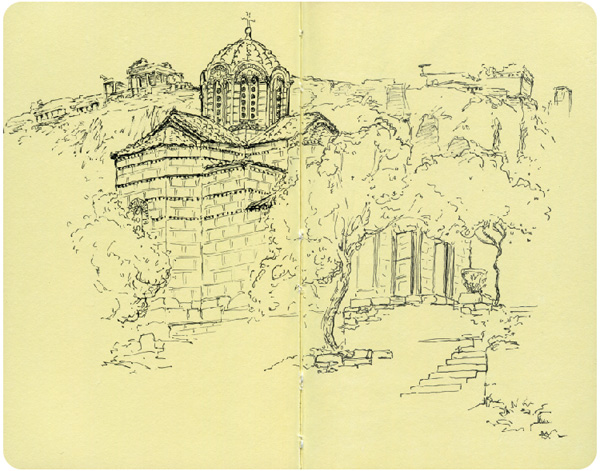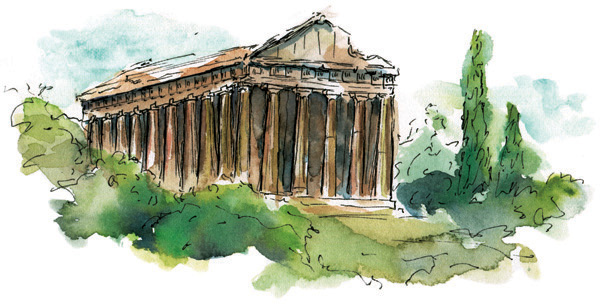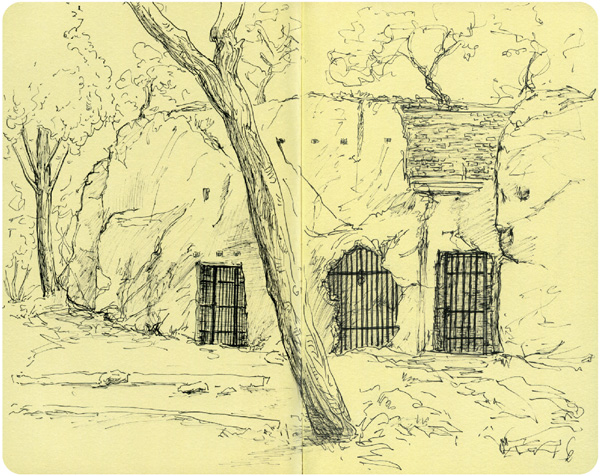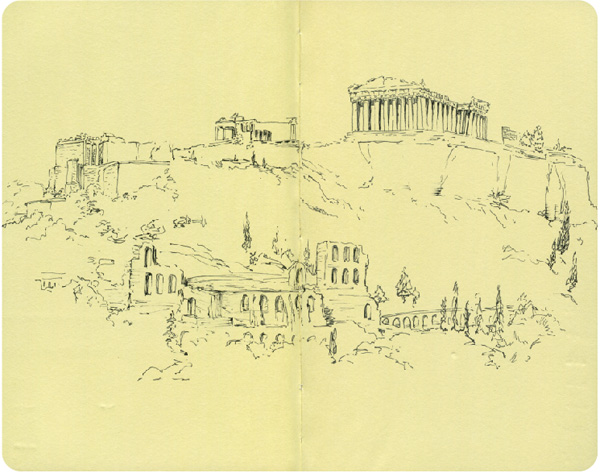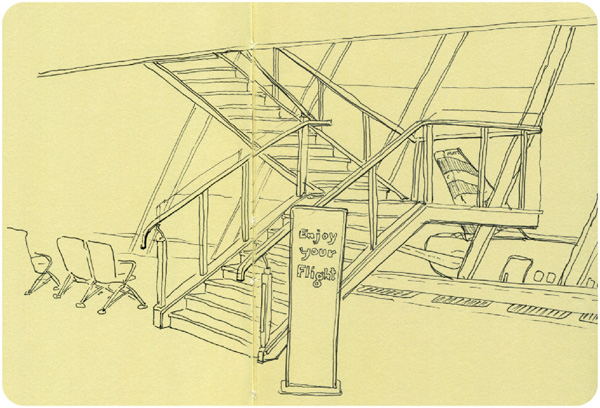 While at the London Heathrow airport and waiting for my flight back to the States, I drew this staircase not to far away from where I was sitting. I could tell the focused state of mind I had developed while traveling in Greece was still present. My mind was crystal clear and I felt so relaxed. I wish this state of being could last forever but I know my cell phone will need to be turned back on, email will have to be answered, and my life will return to normal. On the other hand now that I have some perspective on my life, this is a good time to see the changes that need to be made in order to add more meaning and focus. Above all, it’s important for me to take the time to slow down, be apart of the world around me, and draw.
While at the London Heathrow airport and waiting for my flight back to the States, I drew this staircase not to far away from where I was sitting. I could tell the focused state of mind I had developed while traveling in Greece was still present. My mind was crystal clear and I felt so relaxed. I wish this state of being could last forever but I know my cell phone will need to be turned back on, email will have to be answered, and my life will return to normal. On the other hand now that I have some perspective on my life, this is a good time to see the changes that need to be made in order to add more meaning and focus. Above all, it’s important for me to take the time to slow down, be apart of the world around me, and draw.
Art Supplies Used While Traveling in Greece
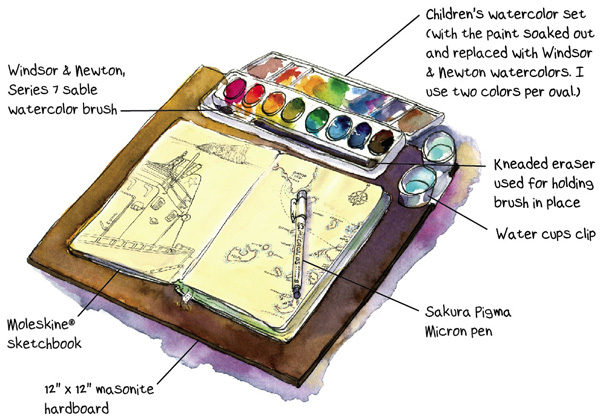 I have experimented with many different art supplies over the years, and my supply list is always evolving. Here is a list of the items I used in Greece, each of which I tested extensively before my trip to ensure its necessity and functionality. Most of these supplies can be found at any art supply store.
I have experimented with many different art supplies over the years, and my supply list is always evolving. Here is a list of the items I used in Greece, each of which I tested extensively before my trip to ensure its necessity and functionality. Most of these supplies can be found at any art supply store.
• Sakura Pigma Micron pens size 01-08
• Windsor & Newton professional-grade tube watercolors
• Children’s watercolor set (with the paint soaked out and replaced with W&N watercolors)
• 12†x 12†masonite hardboard
• Water cups clip
• Windsor & Newton, Series 7 sable watercolor brush
• Technical pencil (never needs sharpening)
• Moleskine watercolor sketchbooks
• Moleskine regular sketchbooks
• Arches hot press watercolor blocks 7†x 10â€
• Plastic knife (for removing pages from the watercolor block)
• iPhone for pictures, video, blog posts (so much contained in one gadget makes it a winner)
• Timbuk2 messenger bag
• Three-legged fold-up chair
• Notebook for writing thoughts
• Kneaded eraser
The Agora
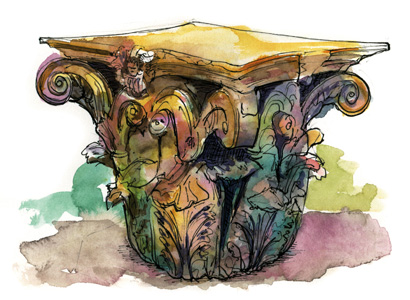 We begin our day in the Agora, an ancient marketplace just below the Acropolis. It looks like an over-grown garden with trees, bushes, and flowers but with the added bonus of architectural ruins scattered about. Although few people are present, it’s easy to imagine the crowds shopping thousands of years ago. I walk along Panathenaic Way as it cuts across the Agora. In ancient times, Greeks used this pathway not only for the market but also for the Panathenaic festival (the largest and most important festival in Athens) that was held each year in honor of Athena, the patron Goddess of Athens. The procession began at dawn, just north of here at the Dipylon Gate in the Potter’s Quarter. It then proceeded through the Agora and wound up the Acropolis to the Erechtheum where a peplos (a full length garment warn by women) was placed on the statue of Athena. Each year young women wove a new peplos specifically for the event.
We begin our day in the Agora, an ancient marketplace just below the Acropolis. It looks like an over-grown garden with trees, bushes, and flowers but with the added bonus of architectural ruins scattered about. Although few people are present, it’s easy to imagine the crowds shopping thousands of years ago. I walk along Panathenaic Way as it cuts across the Agora. In ancient times, Greeks used this pathway not only for the market but also for the Panathenaic festival (the largest and most important festival in Athens) that was held each year in honor of Athena, the patron Goddess of Athens. The procession began at dawn, just north of here at the Dipylon Gate in the Potter’s Quarter. It then proceeded through the Agora and wound up the Acropolis to the Erechtheum where a peplos (a full length garment warn by women) was placed on the statue of Athena. Each year young women wove a new peplos specifically for the event.
Church of the Holy Apostles in the Agora, Athens
At the far end of the Agora, I find an engaging view of a Byzantine church with the ever-present Acropolis hovering in the distance. This will be a great place to start the day. I pull out my sketchbook, unfold my chair, and begin drawing. Thinking back to what I learned on Mykonos yesterday, I start with the most important object, the church dome, and work outward, eyeballing the proportions as I go. By drawing the overall size and perspective of the church first, I won’t have to worry about running off the page when my mind is preoccupied drawing the details.
Temple of Hephaestus in the Agora, Athens
Looking around for a new subject to paint, I walk towards the Temple of Hephaestus, stepping over puddles from last night’s rain as I go. I take a deep breath. The morning air is rich with moisture and the scent of flowers. After finding a good view of the temple, I pull out my chair and unfold it. The temple, from this perspective, sits on top of a hill overlooking the Agora with green gardens surrounding it.
The Prison of Socrates
On our last day in Athens, we have one prominent place left to visit, the Hill of the Muses. As we make our way around the Acropolis through zig-zagging streets, we pause for a moment to watch an organ grinder. An old man wearing a bowler hat pulls the crank while lighting up a cigarette, and an unfamiliar song begins to resonate outward. The organ itself is really the attraction, with fringe, jewelry, flowers and old black-and-white movie-star photos decorating its sides. A young boy runs around with hat in hand collecting money, replacing the traditional monkey.
With our day quickly passing, we continue our walk up the Hill of the Muses overlooking the city. Our first stop is the Prison of Socrates, where the philosopher was supposed to have been jailed before they forced him to drink deadly hemlock. He had been convicted of corrupting the youth of Athens with his philosophical teachings. This is also the site where, during the Second World War, all the Acropolis’ artifacts were hidden from the Nazis. I’m not that interested in drawing the site but my dad is insistent, so I pull out my gear and give it a shot. I’m not sure what I should include in the drawing. I know its historical significance, but the hill seems uninteresting and flat. I step back a bit to let the tree trunk cross the image and give the drawing depth. Now it starts taking on new life, and I’m glad my dad recommended drawing here.
Akropolis from on top of the Hill of the Muses
When in Athens, it’s impossible to miss the giant mountain of rock called the Acropolis. It’s especially impressive in the areas of town where the Parthenon can be seen crowning the top. One of my favorite vantage points is on top of the Areopagos. When I first arrived in Athens, I climbed up the slippery rocks to the top of the hill and watched the full moon rise above the Parthenon. Unfortunately at the time, I was unable to see well enough in the dark to draw.
Today on the last day of my trip to Greece, I found another great view while climbing down the Hill of the Muses and with the afternoon sun behind me, I was able to draw. From there, I could see the Acropolis in all its splendor, dominating the city below.
Dream Drawing of a Hidden Reality
During the night, I had a dream that I was walking through one of my drawings of a Greek city, maybe Plaka in Athens. This alternate reality slowly transformed, revealing the actual town underneath the dream-drawing, as if it was a hidden structural reality upon which life is based.
